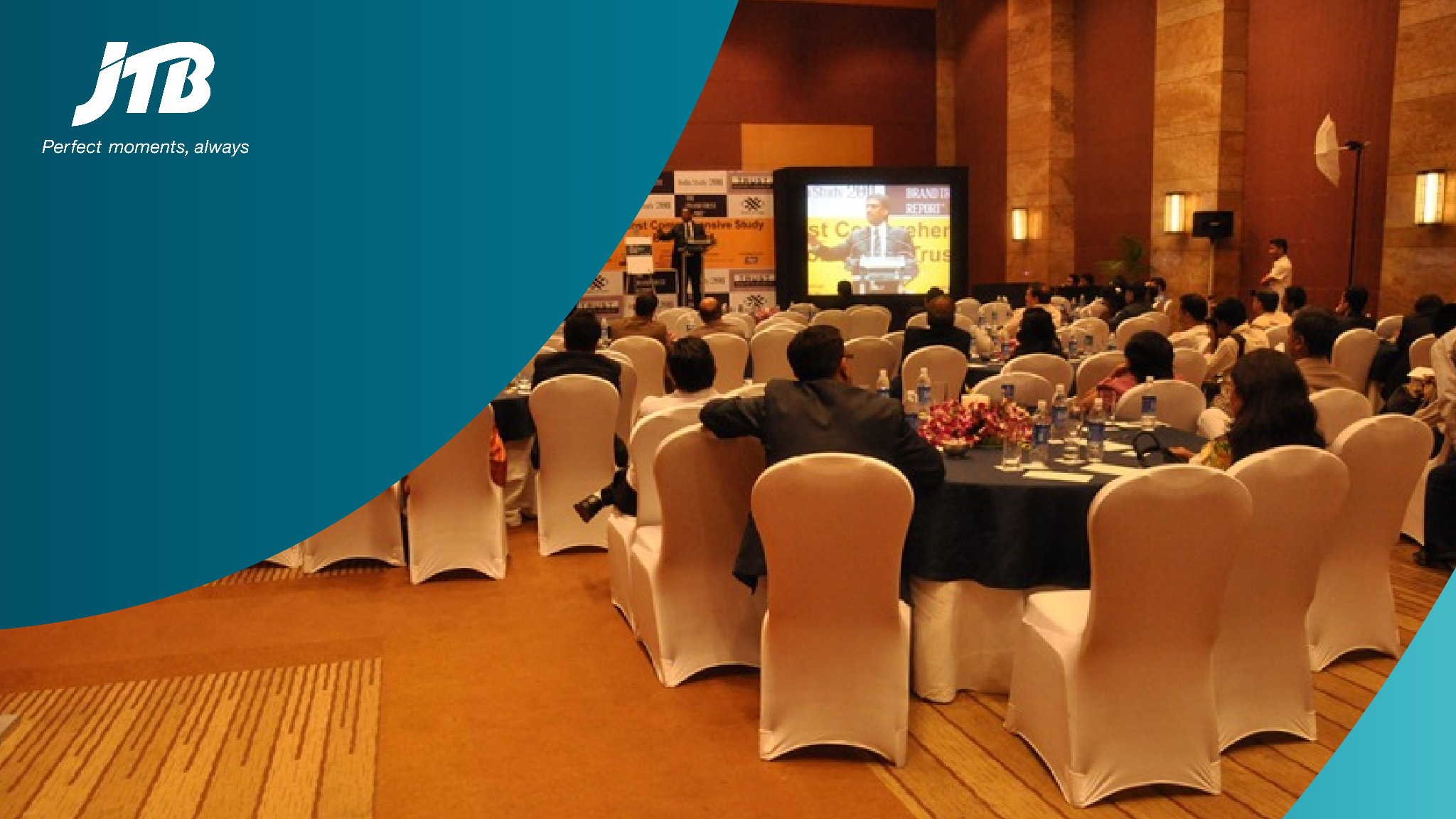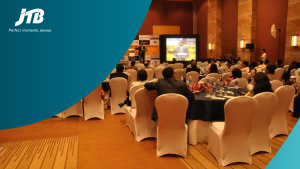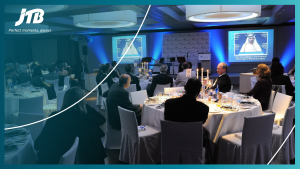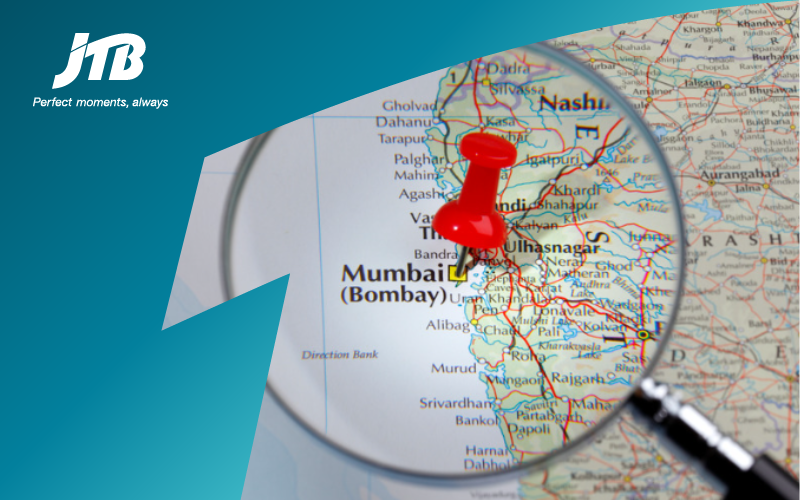A carefully planned corporate event management process enables organisers to break down activities into manageable parts. It allows workflow monitoring and maintaining attention throughout the event.
By incorporating a systematic process, event staff and organisers can consistently determine the current status of the event management plan and how the pending tasks contribute to the main event strategy.
This blog will explain the basic concept of corporate events and the fundamental steps in the corporate event management process. Whether you’re planning a conference, seminar, or team-building retreat, JTB India provides the solution you need to impress your attendees and achieve your business goals.
What are Corporate Events?
Corporate events are gatherings of individuals with a clear goal, such as sales talks, networking events, product launches, or team-building activities. These events are crucial for organisations’ growth and success. They enable their entry into new markets, strengthen connections with clients, and boost workers’ confidence.
A successful corporate event requires particular organisation and planning. Numerous factors must also be considered, from choosing a suitable venue to creating an engaging plan. These are essential for ensuring the event’s success.
4 Corporate Events by Size
The variety of corporate events includes client hospitality and team away days, in addition to internal training seminars and company conferences. Hence, it is advisable to evaluate the size of the corporate event for effective corporate event management.
Micro Events
Frequently, these events manifest as workshops or more intimate seminars, accommodating a maximum of one hundred attendees. Room booking, provision of presentation facilities, provision of break-out refreshments, and registration are all that are required to organise these micro-events. Organising a conference with 500 attendees is less complicated than planning an away day or providing hospitality for 50 senior managers; thus, the term “simple events” is deceptive in its description.
Small Events
Small events are defined as those that accommodate 100 to 250 attendees. Seminars, departmental conferences, and training days are examples of small events. Event organisers must attend transport, lunch, refreshments, audiovisual facilities, online registration, schedules of multiple break-out sessions, and the main stage.
Midsize Events
Midsize events are more dependent on technology. These include leadership summits where key customers meet with senior executives or company-wide conferences that accommodate a maximum of 1,000 delegates.
Incorporating pre-event communication, a branded website, and an event mobile application into budget considerations is essential. Delegates need transportation to and from the venue and hotel accommodations. A multi-stream complex conference schedule might require incorporating evening entertainment or a pre- or post-event reception.
Large-Scale Events
Enterprise technology tools are necessary to oversee various aspects of large-scale events, including delegate flights, online registration, hotel room reservations, and budgets.
Personnel, catering, registration, speaker, and delegate administration will require scale-appropriate planning. Conventions, for example, can accommodate about 10,000 participants and span several days.
7 Fundamental Steps in the Corporate Event Management Process
Now, let’s have a look at the entire corporate events management process.
1. Event Objective
When a corporate event is requested, the initial probe should be, “What is the event’s purpose?” Gaining a comprehensive understanding of key stakeholders’ desired deliverables will enhance your planning capabilities. You can effectively convey your ideas in a manner that is understandable to your managers.
Executing clearly defined goals and objectives for an event significantly facilitates strategizing, advertising, and budget adherence. The objectives of the event should be as follows:
- What is the intended result, and by what date must it be accomplished?
- Return on objectives, return on investment, or both?
- Verify that the event objective is attainable; otherwise, senior executives will perceive it as unsuccessful.
- An overall aim must be connected to the organisation’s goals.
- Strategize to accomplish the event objective within two time periods. Evaluating the results of the initial training seminar requires organising additional seminars or a subsequent event.
To achieve these objectives effectively, consider leveraging JTB India’s Strategic Meetings Management (SMM) service. Their expertise in optimising event-related processes, negotiating favorable contracts, centralising procurement, streamlining workflows, and automating tasks ensures that your event planning is efficient and successful. By using their SMM service, you can align your event goals with the organisation’s objectives, achieve cost savings, and enhance the overall quality of your corporate events.
2. Event Budget
Budget conditions can influence every part of corporate event planning, including the selection of venue, catering, entertainment, speakers, technology, and personnel.
Determine whether your budget is limited to expenditures or can be augmented by revenue generated from sponsors, exhibitors, or other secondary sources.
Has this event happened earlier?” If so, the previous budget was used as a starting point while accounting for inflation and changing requirements.
Previous budget figures are valuable resources for elucidating the pricing structure of specific suppliers. When contacting suppliers for preliminary estimates, use these to ensure you are not overcharged.
However, every event budget must incorporate flexibility. It is imperative to establish a fund and manage the overall budget in the event of unexpected expenses and the provision of estimates rather than fixed prices for supplier costs. Moreover, create a complete list of all budget line items in the event lifecycle. It including;
- Food and beverage
- Lodging and travel
- Personnel expenses
- Marketing and service charges
- Venue rental and AV
- Speaker fees
- Accommodation and travel costs once you have obtained supplier cost estimates.
Once you have obtained supplier cost estimates, leveraging JTB India’s platform for corporate event management process through JTB Connect can significantly enhance your budget management. JTB Connect technology streamlines event planning and sourcing by providing a centralised, cloud-based platform that ensures compliance, enhances visibility, and enables precise budget tracking. This technology allows you to manage your event within the client’s budget effectively, mitigating risks and achieving cost savings. By using JTB Connect, you can ensure that all aspects of your event are meticulously planned and executed within financial constraints.
3. Venue Sourcing
The event’s source also influences the venue selection process. To impact prospective or existing clients, stakeholders require the venue to fulfill its needs by providing an unforgettable experience.
Budget considerations, capacity, location, availability, and logistical aspects will also impact your venue selection. A comprehensive understanding of these event prerequisites will enable you to evaluate potential venues. So, send requests for proposals (RFPs) and coordinate site visits.
Corporate event venues that implement seasonal pricing reduce rent during specific periods of the year. Determine how much the venue of your choice will cost on the date you specify. Having flexible dates enables you to negotiate a more favorable rate at your preferred venue.
3 Steps to Venue Sourcing
Step 1: Find venues
- Understand the meeting’s requirements and objectives. Establishing these in advance will reduce the search procedure.
- Consider the input provided by the attendees. Is this event held annually? If the venue received low ratings from attendees in the previous year, consider the feedback to select a venue that will be more well-received.
- Collaborate with your team members or other stakeholders to identify the most critical factors in the event.
Step 2: Create the ideal RFP
- The purpose must now be defined, as the general objectives and requirements are already known. Make the objectives and requirements of this event plain.
- Be specific. Provide each detail possible regarding the event.
- Although nobody enjoys discussing money, you must communicate your financial demands. A venue expense is significant and has the potential to determine the economic viability of an event.
- Clarify your deadlines. Provide venues with a date and time that will allow sufficient time to respond.
- Avoid starting from the beginning. Retrieve a template from the web.
- Be prepared to respond to venues’ inquiries regarding the event or proposal.
Step 3: Proposal submission and evaluation
- You can search and filter venues using a venue procurement tool and send a single RFP to multiple venues simultaneously.
- Generate a compilation of qualitative factors, which are those that lack definite characteristics.
- Evaluate proposals through the designated venue sourcing tool or the laborious importation of data into a spreadsheet.
- Compare the responsiveness and helpfulness of the venues to determine the extent to which selecting one will benefit you.
- Review meeting rooms to ensure their dimensions and design suit the intended event.
4. Event Marketing
Promoting and marketing a corporate event is crucial to maximising attendance and accomplishing event goals. One implements various corporate event engagement activities, such as email marketing, social media, and collaborations with other brands. Potential attendees can be encouraged to commit to the event. It helps to generate interest and establish a pre-event page alongside early bird discounts.
Examples of event marketing assets include a mobile application, social media channels, and a branded website. It would be advantageous to generate interest and promote the event by designing and producing posters, pamphlets, pin badges, and other supplementary materials.
The advent of modern corporate event administration software solutions has simplified the development of a bespoke event website. Technical proficiency is not obligatory, and knowledge of HTML is unnecessary. An entirely new website can be constructed using a straightforward drag-and-drop interface. Incorporate on-site advertising, such as banners, signs, brochures, pamphlets, and other event security, into your marketing strategy.
5. Attendee Engagement
Attendees’ expectations and requirements vary based on persona, age, and region. If a corporate event fails to generate engagement, attendees’ ability to retain information will be negatively impacted.
In this mobile-first, digital era, the human attention span has diminished considerably. Consequently, corporate event organisers have been compelled to adopt new session formats that circumvent information overload.
Priorities should include setting up live polling, integrating feedback mechanisms such as technology tools, ensuring that objectives and anticipations are aligned, and maintaining an atmosphere of authenticity.
Complete sessions should feature delegate participation. Implement strategies such as live polling, actual-time responses to questions, round table conversations, and other processes to sustain high levels of audience engagement and concentration.
The conference break-out sessions should be structured to offer participants specific interactive material. A frequent drawback in event planning is reducing them to mini-keynotes.
6. Post-Event Follow-Up
It is essential to conduct post-event follow-up to assess the event’s success, maintain relationships with sponsors and attendants, and ensure that attendees had a positive experience. Post-event strategies such as thank-you notes, post-event surveys, a dedicated post-event page, sharing pertinent content, and vigilant engagement on social media can maintain the momentum generated during an event and generate interest in subsequent events.
These techniques can help maintain the attendees ‘ interest in the event and its sponsors and sustain the conversation. Additionally, post-event follow-up can strengthen relationships with potential sponsors for future events and generate leads for the sales team.
7. Corporate Event Planning Checklist
In addition to the best recommendations mentioned above, implement these 21 steps to ensure the success and efficacy of your corporate event planning.
- Determine the main purpose and principal objectives that this event is designed to accomplish.
- Identify the target audience to determine the intended message and key points that will resonate with them.
- Determine how the event will contribute to the company’s strategy. What are its objectives for the long term?
- Construct an exhaustive inventory of every budget line item associated with the event lifecycle.
- Establish a planning committee and distribute its responsibilities.
- Commit to paper a timetable for the planning meetings.
- Establish the date or dates on which the event will occur.
- Construct an initial budget using historical cost data and supplier quotations.
- Compile an inventory of the requirements for the venue.
- Evaluate and negotiate venues.
- Arrange the venue’s layout.
- Secure speakers.
- Design and execute a marketing strategy for the event.
- Construct a schedule for the event, incorporating sufficient time for transitioning between sessions and activities and provisions for potential technical challenges and delays.
- Make arrangements for lodging and transportation.
- Construct meal and beverage menus with dietary restrictions in mind.
- Create and distribute event materials.
- Recruit or confirm event personnel.
- If necessary, rehearse the speakers.
- Conduct post-event follow-ups with presenters and attendants to express gratitude for their participation and to provide them with important insights.
- Perform surveys, collect feedback, and compile conclusive cost estimates for later use.
Conclusion
Effective corporate event management process requires a strategic approach that blends creativity with practical planning and flawless logistical execution. By systematically addressing each stage of the process, event managers can create memorable and impactful experiences that align with organisational goals and leave a lasting impression on attendees.
JTB India’s MICE (Meetings, Incentives, Conferences, and Exhibitions) services are designed to support every aspect of your event management needs. From meticulous planning to seamless execution, our team ensures that your events are not only successful but also unforgettable. Connect with JTB India today to explore our tailored event management solutions and start planning your next remarkable event. Let us help you turn your vision into reality with our expertise and dedication to excellence.




























